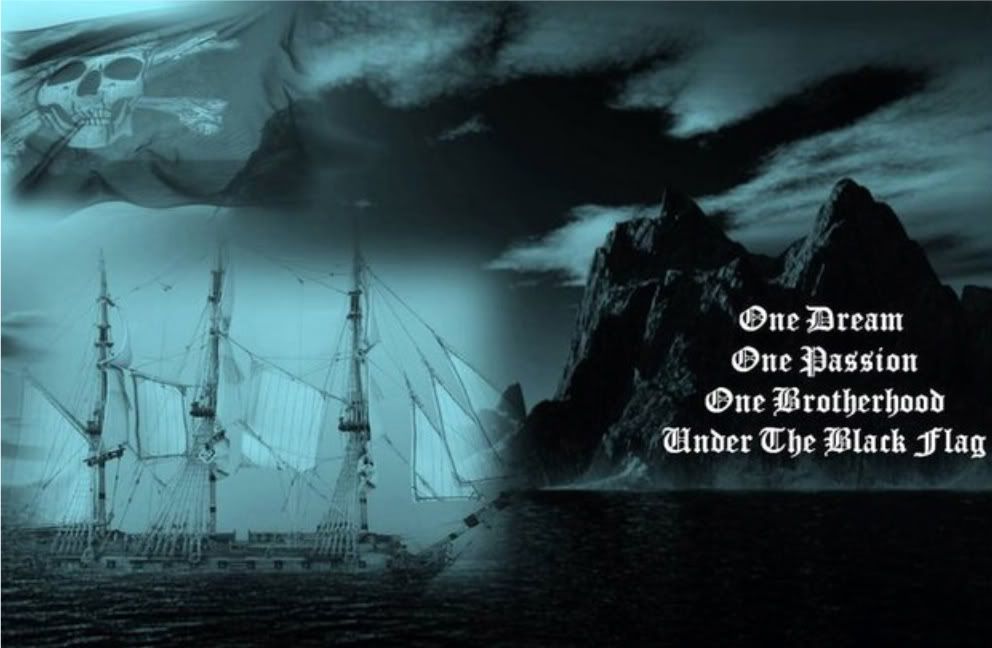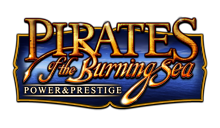The Privateers
American, English, France, Privateers 2:44 μ.μ.
The Privateers
The English
Henry III of England granted the first Letter of Reprisal in 1243. The precursor of the Letter of Marque, these letters licensed a ship to attack enemy ships without fear of punishment. In exchange, the king received a share of all plunder and increased the size of his navy without having to pay to crew, maintain, or supply them. Originally, ships granted such licenses were called “private men-of-war,” but this was shortened to privateer. In time, the term privateer came to represent the ship, the captain, and the crew.
Privateering flourished between the 16th and 18th centuries, a time when European countries waged almost constant war against each other. In theory privateers attacked only enemy ships and did so in accordance with the restrictions delineated in their letters of marque. In reality some privateers bent the rules and attacked ships of friendly nations, which constituted acts of piracy.
Even though privateers possessed licenses giving them permission to plunder enemy merchant ships, the enemy didn’t necessarily agree with the legality of what they did. Spain viewed any such attacks on their ships as acts of piracy, and treated captured privateers accordingly.
Queen Elizabeth I’s privateers were known as Sea Dogs. The best known of these was Francis Drake, whom she called “her pirate.” His ventures brought her great wealth, and in 1581 she knighted him. Other Sea Dogs included John Hawkins and Thomas Cavendish. Although Sir Walter Raleigh wasn’t a privateer, he did promote them. He used the proceeds garnered from these ventures to fund expeditions to his Virginia colony. Elizabeth, however, deemed privateering of greater import than colonization, which is why Raleigh’s ships didn’t return to Roanoke as planned and why what became of the Lost Colony of Roanoke remains a mystery to this day.
Early privateers sailed in fifty- to one-hundred-ton barques with crews of forty or fifty men. Later, they converted merchant ships with three times the tonnage. Drake’s Golden Hind, an English race-built galleon with a sleeker hull than that of a Spanish galleon, measured seventy-five feet long and twenty feet wide, and weighed 120 tons. She carried eighteen guns of various size. The English galleons were fast, well armed, and easy to maneuver. Instead of erecting the towering superstructures common on Spanish galleons, the English ones were low and rose gradually toward the quarterdeck. They preferred guns on carriages with four wheels instead of two large ones. Their gun crews trained regularly because these English privateers avoided close contact with the enemy and relied on the guns to win the confrontations.
In contrast, the typical Spanish galleon had a tonnage of three to five hundred. The largest, the flagships of the fleet, never engaged privateers in the Spanish Main. There they used smaller galleons and naos, well-armed carracks. Yet the galleon remains the ship most associated with piracy in the Spanish Main. With a high forecastle and towering sterncastle, she was an unwieldy ship. Her capacity for cargo lessened her speed, and she often carried passengers, who hindered the crew when they had to fight. These galleons carried a lot of firepower and soldiers, but rarely employed either unless boarding was imminent.
Drake, who was born in Plymouth in 1540, earned the nickname “El Dragón” from the Spanish. He began his sailing career with his cousin, Sir John Hawkins, who had a knack for combining commerce, warfare, and piracy with national defense. During his lifetime, he was a slave trader, pirate, naval administrator, and national hero. He was the first Sea Dog to attempt to break Spain’s monopoly in the New World. Elizabeth knighted him in 1588, the same year in which he led a squadron against the Spanish Armada. He died in 1595 while on a raid with Drake, who died the following year of fever while at sea.
The French
The kings of France also supported their privateers, known as corsairs. After Réné Duguay-Trouin captured three East Indiamen, he was presented to Louis XIV. Duguay-Trouin (1673-1736) was one of France’s best-known corsairs. His family operated a shipping business in Saint Malo, a port favored by the corsairs. At sixteen he joined the navy, commanded his first privateer at eighteen, and succeeded to the command of a forty-gun ship at twenty-one. In 1711, he captured Rio de Janeiro and held the governor for ransom. Investors in this venture doubled their money, and Duguay-Trouin earned a promotion to admiral. His maritime career spanned twenty-three years and during that time he captured over three hundred ships, including sixteen warships.
While Americans and French considered Saint Malo “La Cité Corsaire,” the English had another name for the port - “nest of wasps.” During the seventeenth century, Saint Malo grew rich off the profits of the privateers. In 1693, the English converted a merchant ship into a floating bomb with which they hoped to destroy the city, but it exploded in the harbor and the only casualty was a cat.
Saint Malo began its love affair with privateers in the 9th century when they armed merchant ships to protect themselves against the Vikings. Another port that gained notoriety as a haven was Dunkirk. Sailing from this port under letters of marque from France or America, over sixty privateers captured hundreds of prizes in the Irish Sea and English Channel.
One privateer based in Dunkirk was Jean Bart (1651-1702). At the age of twelve he joined the Dutch navy. As a privateer, he captured five ships on his first voyage. Louis XIV honored him in 1694, and two years later he captured twenty-five ships. An equally outstanding feat involved his escape from the English who captured him at Plymouth. He crossed the English Channel to safety in a rowboat.
Robert Surcouf (1773-1827) wished to be a privateer, but was unable to secure the proper papers. Since the British blockaded French ports during the French Revolution and Napoleonic Wars, he based his operations on Mauritius, a French-owned island, and raided British shipping in the Indian Ocean. When French authorities confiscated his first prize because he lacked a letter of marque, he sailed to France, obtained the license, and returned to privateering. His fame grew, not only because of his successes, but also because of his bravery. He once fought twelve Prussian soldiers at one time, and won. Such notable deeds were common among French privateers and made them national patriots. Ships and streets were named for them, and privateering proved such a profitable venture that even the Bishop of Saint Malo invested in several ventures.
During the War of the Austrian Succession (1739-1748), the French islands of the Lesser Antilles provided ideal bases from which the corsairs staged their expeditions. They preyed on British shipping in the Caribbean and the Atlantic. At times they sought shelter at the French Canadian fortress of Louisbourg. Their raids so endangered merchant shipping during the Seven Years War (1756-1763) that the British made it their priority to capture Louisbourg, Martinique, Guadeloupe, and Dominica - the ports providing safe havens for the corsairs. Even so, these sea raiders captured more than two thousand ships during the first six years of the Napoleonic Wars.
The Americans
When the colonies declared their independence from Britain, their navy consisted of only thirty-four ships. Since that number was insufficient to mount a war against a more powerful enemy, the fledgling nation issued letters of marque to more than four hundred privateers whose attacks on British shipping crippled that country’s trade. The cost to insure British ships increased six-fold if those vessels sailed without protection.
Many American privateers sailed from Philadelphia, the largest colonial port of the day. The Dispatch was so eager to capture an enemy ship she sailed from port unarmed in 1776. Within a few days she succeeded in her venture and sailed her prize to France. Other privateers sailed from Baltimore, where shipbuilders converted merchant ships to meet the needs of the privateers. Before long, however, builders designed a vessel expressly built for privateering - the schooner. Although fairly small, she was very fast. Her foremast was shorter than the mainmast, but when she sailed with a tail wind, the square-rigged topsail of the foremast boosted her speed. These heavy schooners had crews of over 150 men and carried enough armament to engage British frigates. Baltimore became the premier port for privateers.
Like pirates, privateers preferred not to fight. They could be equally brazen. Jonathan Haroden (1745-1803) came alongside an English ship and demanded her surrender within five minutes. He stood beside a cannon with a lighted wick and waited. The ship struck her colors and Haroden captured her. Unbeknownst to the English, his threat was a bluff. Had he fired the cannon, it would have been his one and only shot because he had no ordnance with which to reload the gun.
Privateers of the American Revolution took over three thousand British vessels. They captured much-needed muskets and gunpowder, which they delivered to the Continental Army. The men who served aboard privateers sailed under the rule of no prey no pay. They only received shares of whatever plunder they acquired. For some, like those aboard the Rattlesnake, they returned home wealthy men after capturing prizes worth over $1,000,000 on a single voyage. The America (which weighed 350 tons, carried twenty guns and 120 crewmembers) took forty prizes, netting her owners a profit of over $600,000. The most successful privateer, a brig called Yankee out of Bristol, Rhode Island, captured forty prizes worth more than $3,000,000.
Not all privateers were so successful. The Dash sank during a storm off the coast of Maine, yet residents still remember her because her ghost continues to sail their coastal waters. During World War II, a couple making love on the beach saw the ship loom out of the fog.
American privateers played an equally important role during the War of 1812. Two months after war was declared, 150 privateers put to sea. The United States Navy owned twenty-three ships with 556 guns. During the war, they captured 254 British ships. In contrast the 517 privateers with their 2,893 guns took 1,345 prizes and cost the British an estimated $45.5 million in damage. As a result insurance rates for British merchants sailing the Irish Sea rose thirteen percent. The privateers also captured 30,000 prisoners.
Napoleon’s surrender, however, brought the full wrath of the British navy to bear on America. Their blockade of American ports brought commerce to a virtual standstill and privateering dwindled.
One of the last privateers was a gentleman named Jean Laffite. To this day, he remains steeped in mystery, but no one disputes the fact that he was a hero. Without his armament and men, the Americans might have lost the Battle of New Orleans. Although Laffite sailed with letters of marque from Cartagena, which was fighting for its independence from Spain, many considered him a pirate.













